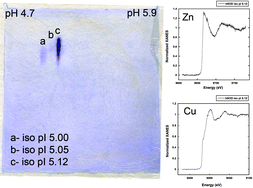Direct speciation of metals in copper-zinc superoxide dismutase isoforms on electrophoresis gels using X-ray absorption near edge structure†
Abstract
X-Ray absorption near edge structure (

- This article is part of the themed collection: 2007 International Symposium on Metallomics, Nagoya, Japan

 Please wait while we load your content...
Please wait while we load your content...